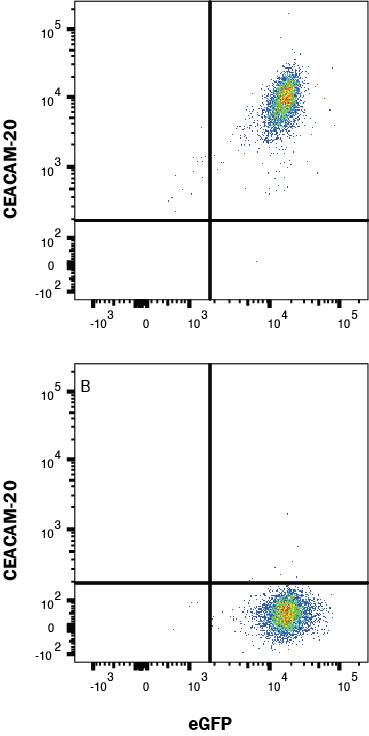Human CEACAM-20 Antibody
R&D Systems, part of Bio-Techne | Catalog # MAB9416


Conjugate
Catalog #
Key Product Details
Species Reactivity
Human
Applications
Flow Cytometry
Label
Unconjugated
Antibody Source
Monoclonal Mouse IgG1 Clone # 1032339
Product Specifications
Immunogen
Human embryonic kidney cell HEK293-derived human CEACAM-20
Gln31-Gly450
Accession # Q6UY09-1
Gln31-Gly450
Accession # Q6UY09-1
Specificity
Detects human CEACAM-20 in direct ELISAs.
Clonality
Monoclonal
Host
Mouse
Isotype
IgG1
Scientific Data Images for Human CEACAM-20 Antibody
Detection of CEACAM-20 in HEK293 Human Cell Line Transfected with Human CEACAM-20 and eGFP by Flow Cytometry
HEK293 human embryonic kidney cell line transfected with (A) human CEACAM-20 or (B) irrelevant protein, and eGFP was stained with Mouse Anti-Human CEACAM-20 Monoclonal Antibody (Catalog # MAB9416) followed by Allophycocyanin-conjugated Anti-Mouse IgG Secondary Antibody (F0101B). Quadrant markers were set based on control antibody staining (MAB002). Staining was performed using our Staining Membrane-associated Proteins protocol.Applications for Human CEACAM-20 Antibody
Application
Recommended Usage
Flow Cytometry
0.25 µg/106 cells
Sample: HEK293 Human Cell Line Transfected with Human CEACAM-20 and eGFP
Sample: HEK293 Human Cell Line Transfected with Human CEACAM-20 and eGFP
Formulation, Preparation, and Storage
Purification
Protein A or G purified from hybridoma culture supernatant
Reconstitution
Reconstitute at 0.5 mg/mL in sterile PBS. For liquid material, refer to CoA for concentration.
Formulation
Lyophilized from a 0.2 μm filtered solution in PBS with Trehalose. *Small pack size (SP) is supplied either lyophilized or as a 0.2 µm filtered solution in PBS.
Shipping
Lyophilized product is shipped at ambient temperature. Liquid small pack size (-SP) is shipped with polar packs. Upon receipt, store immediately at the temperature recommended below.
Stability & Storage
Use a manual defrost freezer and avoid repeated freeze-thaw cycles.
- 12 months from date of receipt, -20 to -70 °C as supplied.
- 1 month, 2 to 8 °C under sterile conditions after reconstitution.
- 6 months, -20 to -70 °C under sterile conditions after reconstitution.
Background: CEACAM-20
References
- Tchoupa, A. et al. (2014) J Cell Commun Signal 12:27.
- Zhang, H. et al. (2013) PLoS ONE 8:e53359.
- Zebhauser, R. et al. (2005) Genomics 86:566.
- Beauchemin, N. Arabzadeh, A. (2013) Cancer Metastasis Rev 32(3):643.
- Kuespert, K. et al. (2006) Curr Opin Cell Biol 18:565.
- Murata, Y. et al. (2015) PNAS E4264.
- Obrink, B. (1997) Curr Opin Cell Biol 9:616.
- Horst, AK. Wagener, C. (2004) Handb Exp Pharmacol 283.
- Kitamura, Y. et al. (2015) Genes to Cells 20:578.
- Kotani, T. et al. (2016) Expert Review of Gastroenterology & Hepatology. 10:1313.
Long Name
Carcinoembryonic Antigen-related Cell Adhesion Molecule 20
Alternate Names
CEACAM20, GPAD9366, UNQ9366
Gene Symbol
CEACAM20
UniProt
Additional CEACAM-20 Products
Product Documents for Human CEACAM-20 Antibody
Product Specific Notices for Human CEACAM-20 Antibody
For research use only
